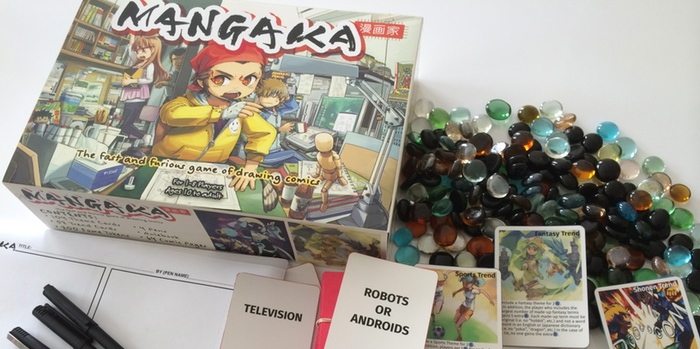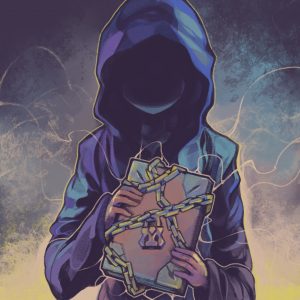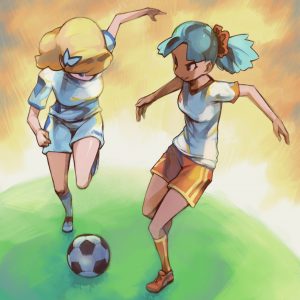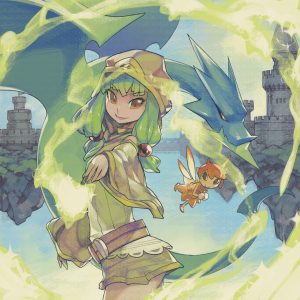Whether you like to draw, like to tell stories, or a little of both, Mangaka: The Fast & Furious Game of Drawing Comics may be a Kickstarter you should look into. Mangaka is Japanese for “comic artist or cartoonist” and in the game of Mangaka you get to be the Mangaka as you furiously try to draw comics and beat out the other hopeful artists.
Mangaka is a great game for drawing enthusiasts and storytellers alike. No great skill in either is required to do well in this game that gives players a 60-minute window of focused drawing fun. Players’ comics, drawn in four 5-minute rounds, are guided by random themes provided by the game.
Mangaka is recommended for 1 to 8 players. You can play with up to eight if you use teams, and rules for solo-play are included. It is currently seeking backers on Kickstarter and, at the time of this writing, is three-quarters of the way to their $25,000 goal in pledges. Funding opportunities will close May 25th, 2015, at 6 AM PST.
I was intrigued by this game when it first came to my attention. Any game that allows me to enjoy my sub-standard drawing skills has great potential in my mind. My kids and I love to draw, with one of my children often choosing pre-bedtime drawing instead of reading after our father-son reading time every night. Once I received the prototype demo game I was anxious to make some comics!
Components

The Kickstarter lists the following items as the contents of the game.
- 104 Theme Cards
- 52 Trend Cards
- 200 Fame Tokens
- 64 Comic Pages
- 4 pens
- Not listed on the Kickstarter, but I’m told also included, is a 16-page rulebook. I received the rules as a PDF for my review.
There are four different types of comic pages; two-panel, four-panel, six-panel, and eight-panel: one for each increasingly difficult round. The 64 pages provided are good then for 18 “plays” (one person eighteen times, two people playing nine times, etc). Players can download and print more pages at the Mangaka site once released. As a nice touch, each page includes the rules and scoring relevant to the particular round and convenient for each individual’s reference.
For my review the 16-page rulebook was provided as a PDF. The rules were clear and easy to understand. I was able to visualize everything it said without having to reference the rest of the game pieces and we were able to get playing quickly with minimal reference to the instructions.
The picture above is only a prototype and cards in the demo I received were simply printed on cardstock; therefore, I can give no opinion as to the quality of the final materials. The Theme cards will not contain individual artwork, while the Trend cards will. This difference can be seen in the above prototype image and the reason for this is explained further in the review.
How to play
Played over four rounds, Mangaka is focused on quick drawing and storytelling. At the beginning of the game each player is given three “Theme” cards each containing a word or phrase and some explanation. These three words or phrases are what each player’s comic is focused on for all four rounds and do not change. Some examples include “Superhuman Skill,” “Romantic Jealousy,” “Robots or Androids,” “Animal Costumes/Furries/Catgirls,” and “A Childhood Crush.” The game includes 104 Theme cards. That’s over 108,000 different combinations of themes for your comic! As just mentioned, these cards do not include any artwork.
In each five-minute round the Mangaka hopefuls must draw their three Themes into a comic. Mangaka provides pages with two, four, six, and eight panels. In round one, there are two panels, round two uses four panels, then six panels in round three, and finishing with eight panels in the final round. It’s quite tense trying to fill in eight panels in just five minutes! When someone glances at the timer and announces a time–“two minutes!”–gasps of horror sweep through the players. Players win by having the most Fame at the end of the game. At the end of each round, the player gets one Fame point for each Theme represented. The players also receive two Fame points if there is an actual drawing in each panel rather than a scribble or just words, and two more Fame if they manage to express their Themes with three or fewer word bubbles. Unlimited sounds and symbols are allowed.
If that’s not enough to be tasked with, after the first round, “Trends” are introduced. Trends represent the current whims of your comic-viewing public. One round the public may be interested in characters with spiky hair, but in the next round instead the Trend may be two characters becoming romantically involved, the Fanservice Trend, or the Extensive Dialogue Trend where the player scores points for every word bubble with more than ten words in it. In each subsequent round there are more Trends, until in round four you are trying to include your original three Themes as well as four Trends, drawing in eight panels, in just five minutes!
Trend cards include artwork while the Theme cards don’t. Themes represent the artist’s drawing obsession, so no biasing artwork is included. Trends, on the other hand, represent what the public currently wants to see in their comics, thus including biasing artwork that affects all players makes sense. The creator said when I asked about the artwork, “Unlike themes that don’t have art so as not to prejudice the players’ image of, say, ‘Robots and Androids’ or ‘Battle’ in a certain direction, Trends are all about steering the style in a certain direction.” This was a well thought out detail.
The process of scoring is fairly simple. Two Fame points for an actual drawing in each panel, and two Fame for three word-balloons or fewer. For the most part everyone is getting these points. The Themes are a little more subjective. In the standard version of the rules you are able to read your own comic to the group which helps explain what you intended. In the optional “pro” rules, someone else reads your comic while the you remain silent. The one Fame per Theme would be much more difficult in this situation. Last, the Trend cards usually are worth quite a few more points; these often pit artists against each other as well. An example is a Trend card that gives five Fame to the the person with the most speech bubbles with more than ten words: not only does it take a great deal of time to do such wordy word balloons, time that could be spent drawing, but if you don’t have the most speech bubbles you also may have lost your two points for having “less than three” speech bubble points.
Sample Play
After finally getting the whole family sitting down and ready to play, including my wife who is less keen on drawing, I went over the rules and we decided to use the eight-minute round option instead of the standard five-minute. Every round is the same length. Those eight minutes went by quickly. While this is a game that’s going to take forty-five minutes to an hour or more, it blows by. Either you’re frantically drawing, or enjoying each other’s comics. My family of four (two adults and a ten- and twelve-year old) had a great time and were able to incorporate our cards into our drawings. One four-part comic is demonstrated here.
Round One
The Themes I received were, “Fantasy Monsters or Dragons,” “Workplace Humor,” and “Desire for Rebellion.” Everyone else received different Themes and so their comics are about something else. You get to name your comic, and coin a pen name if you so choose.
After eight minutes of frantic drawing I came up with this.

Scoring Round One
Drawing in each space: 2 Fame – Scribbles, or just word balloons do not count.
Three or less speech bubbles: 2 Fame – I have two, actual words on the “report” would have counted as a third.
Fantasy Monsters or Dragons: 1 Fame – Big ol’ dragon in panel 1
Workplace Humor: 1 Fame – Office Space rip-off
Desire for Rebellion: 1 Fame – “One of these days I’m going to burn this place down.”
Total Round One: 7 Fame
You can see from the way it is scored, drawing skills are not necessary. Players can meet the objectives with simple stick figures.
Round Two
Remember, the Themes I received were “Fantasy Monsters or Dragons,” “Workplace Humor,” and “Desire for Rebellion”; these are continued for each round.
This round, however, the person with the lowest Fame draws two “Trend” cards representing the whims of the viewing public. From these two Trends the player picks one Trend that we must all include. My son picked the “Destructive Trend”: Include either of the following, 1) an explosion or 2) a fire/something burning. One point awarded for each panel that includes fires or explosions.

Scoring Round Two
Drawing in each space: 2 Fame
Three or less speech bubbles: 2 Fame – Name on door counts, so three. “Snap” sound does not count.
Fantasy Monsters or Dragons: 1 Fame – Big ol’ dragon
Workplace Humor: 1 Fame – Office Space rip-off, using paper cutter
Desire for Rebellion: 1 Fame – “I worked hard on that report … I’m taking over”
Trend – Fire and explosions: 1 Fame – One panel with dragon blowing fire.
Total Round Two: 8 points
Total: 15 points
Round Three
Themes: “Fantasy Monsters or Dragons,” “Workplace Humor,” and “Desire for Rebellion.”
This round three Trends were drawn and two were chosen.
Trend 1: White Collar Trend: Any player who includes a White-Collar Professional Theme receives 2 points. In addition the player that includes a reference to the largest value of money using a real number and real currency receives five extra Fame.
Trend 2: by chance, Blue Collar Trend. Include a blue collar theme for two points. In addition players get one point for each of the following that the player includes, 1) A character complaining about their job 2) a character’s hourly pay which must be a number less than the local minimum wage, 3) A drawing of a character sweating.

Scoring Round Three
Drawing in each space: 2 Fame
Three or less speech bubbles: 2 Fame – “Burp” is a sound effect, does not count.
Fantasy Monsters or Dragons: 1 Fame – Big ol’ dragon
Workplace Humor: 1 Fame – Office Space rip-off, desk, tie
Desire for Rebellion: 1 Fame – Janitor now saying, “…I am taking over!”
Trend – White Collar: 2 Fame – Smaug is an office worker in a tie. My wage of a Googleplex though was ruled out as “not a real number” so I did not receive five points for having the largest value of money.
Trend – Blue Collar: 2 Fame for showing a janitor. 1 Fame for characters complaining about their jobs. 1 Fame for referencing a below minimum wage hourly wage. I did not get the 1 Fame for showing a character sweating.
Total Round Three: 13 points
Total: 28 Points
Round Four – Final Round
Themes: “Fantasy Monsters or Dragons,” “Workplace Humor,” and “Desire for Rebellion.”
This round five trends were drawn and four were chosen.
Trend 1: Continuity Trend: Name a character or refer by name to an already named character. Reward, one fame for naming a character who showed up in a previous round but didn’t have a name before. Receive two points for each character named in this round that was named in an earlier round.
Trend 2: Character Design Trend: Draw either of the following. 1) a character with big spiky hair, 2) A Character with big sparkly eyes for two points.
Trend 3: Detail Trend: Draw the largest number of panels (by dividing panels into one or more smaller panels). Each panel must have a recognizable drawing in it. Five points for the winning player.
Trend 4: Fanservice Trend: When this trend is played, the player with the lowest Fame chooses which two characters from each manga they would like to see fall in love. Reward of three fame for depicting this. The player chose Smaug and the original office guy to fall in love.

Scoring Round Four
Drawing in each space: 2 Fame
Three or less speech bubbles: 2 Fame – Name tag on desk is number three.
Fantasy Monsters or Dragons: 1 Fame
Workplace Humor: 1 Fame
Desire for Rebellion: 1 Fame – Janitor now saying, “… I am going to burn this place down!”
Trend – Continuity Trend: Smaug was previously named by the nameplate on the door. The other players allowed “Mr. and Mrs. Smaug” to cover both of these so 3 Fame total.
Trend – Character Design Trend: 2 Fame for the spiky janitor hair.
Trend – Detail Trend: 5 Fame. I had the largest number of panels with twelve.
Trend – Fanservice Trend: 3 Fame for Smaug and the Office Guy getting married.
Total Round 4: 20 points
Total: 48 Points
While we only had one winner based off Fame we each had a fun four-chapter comic to show for our frantic work!
In each round most of us were drawing until the last second, so a sense of urgency is prevalent throughout. With varying levels of drawing and storytelling skills, everyone, ages ten, twelve, and old, scored well, depicted what they set out to do, and enjoyed themselves. We mostly found the same when playing in other groups as well.
Again, based on the way this is scored, drawing skills are helpful but not necessary. Players can depict each requirement with stick figures and simple drawings. Telling an ongoing story is not even required with regard to scoring, but most players in the games of Mangaka that I played did try to tell something of an ongoing story. This storytelling was my favorite part of the game. I find that with many of the more creative games like this, though, the scoring is just to provide some structure for a creative and fun experience. I care far less about points and scoring than I do about generating a funny story arc that is cohesive across each of the rounds, even though that is not what is scored.
While artistic talent is certainly beneficial, the extremely quick rounds serve to somewhat lessen that advantage as you cannot take the time that most artists would need to draw what they want. Clearly though, artistic skills are beneficial.
Some other examples of finished products and their themes are provided at the Mangaka Game website gallery.
Verdict
Mangaka is a keeper, and will be revisited in my home. Again, while I’m not a skilled artist, my kids and I love drawing and storytelling. Mangaka gives you roughly a 60-minute window of focused drawing with a purpose. The wild and disparate cards we were dealt created the need for some quick thinking but also gave us the direction through themes and trends to get those creative juices flowing. Sharing the comics and laughing with each other’s jokes and drawing (or lack of drawing) skill was a great family experience.
My wife and I use games in our teaching for various reasons and I can see many uses for this game, from using it to discuss game mechanics to introducing new school subject specific themes and trends based off of a topic, say Hamlet, or the American Revolution, and awarding points off depicting specific learning objectives. Adding your own themes or trends for educational purposes or just for fun would be quite easy.
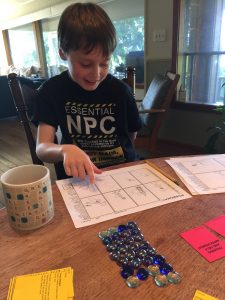
This game is essentially infinitely replayable. There are over 180,000 combinations of themes for a player’s comic. Couple that with the 133,784,560 combinations of trends and the ability to add your own, and you’ve essentially got unlimited play without ever repeating a strip.
My wife and I played this game with players as young as seven and as old as … us. She used it in an elementary school situation and I in the high school in addition to playing it at home with family. Looking through the cards in a hypersensitive-politically-correct-school-environment way for the elementary play through we removed just six of the 156 cards. For instance, we deemed a theme card that required them to draw “guns” not appropriate for the elementary classroom. There were no cards I deemed necessary to pull when playing with my ten- and twelve-year-olds as, while the cards we pulled for the elementary game may encourage the drawing of some violence in a comic, with my kids we just discuss its place and appropriateness in various media.
This game is very portable. We love taking games with us when we travel or camp. For Mangaka just throw the cards in a ziplock bag and as long as you have some drawing materials you’re good to go. You don’t even need the pre-generated comic panels; in a pinch, just draw the panels for each round.
A key component I look for in a game is that no player is ever knocked completely out of the game and unable to play anymore. What fun is it to sit around while everyone else plays a game for another hour or so? In Mangaka you’re never out and for the most part the biggest scores come in the last two rounds, so even if you’re behind there is always hope.
For comparisons, Mangaka is like Pictionary in that you’re trying to quickly generate a drawing that depicts an idea for others to view. However, while time is a factor, it’s not a race against the other team. This allows you to focus more on your drawing and less on getting the idea across extremely quick. This game is also similar to another less known family favorite, Who, What, Where. Who, What, Where is a game where you draw a famous person or type of person such as “Arnold Schwarzenegger” or “police officer,” an action card like “making a cake” or “hailing a taxi,” and a place like “New York” or “the moon.” The player then has a few minutes to depict a scene such as, “Arnold Schwarzenegger, hailing a taxi, on the moon.” You score by getting people to guess the components of your drawing. Mangaka is similar to this in that you are combining disparate and often hilarious things into a single picture, again, with very little time. What I love about Mangaka over either of these examples, though, is that the players are also telling a story with whatever level of creativity they can muster such as with games like, Aye Dark Overlord!, Project Ninja Panda Taco, or Story Cubes.
If you are interested in this game, the Mangaka Kickstarter is running through May 25th, 2015, at 6 AM Pacific Daylight Time. After they reach their funding goal of $25,000, stretch goals include a timer and more Theme cards. There are also various collectibles for higher pledge amounts. This is Jason Thompson’s third Kickstarter. Looking at his past two successfully funded Kickstarters it appears as if they are moving along or completed with happy customers.
Disclosure: I received a prototype review copy of this game.
